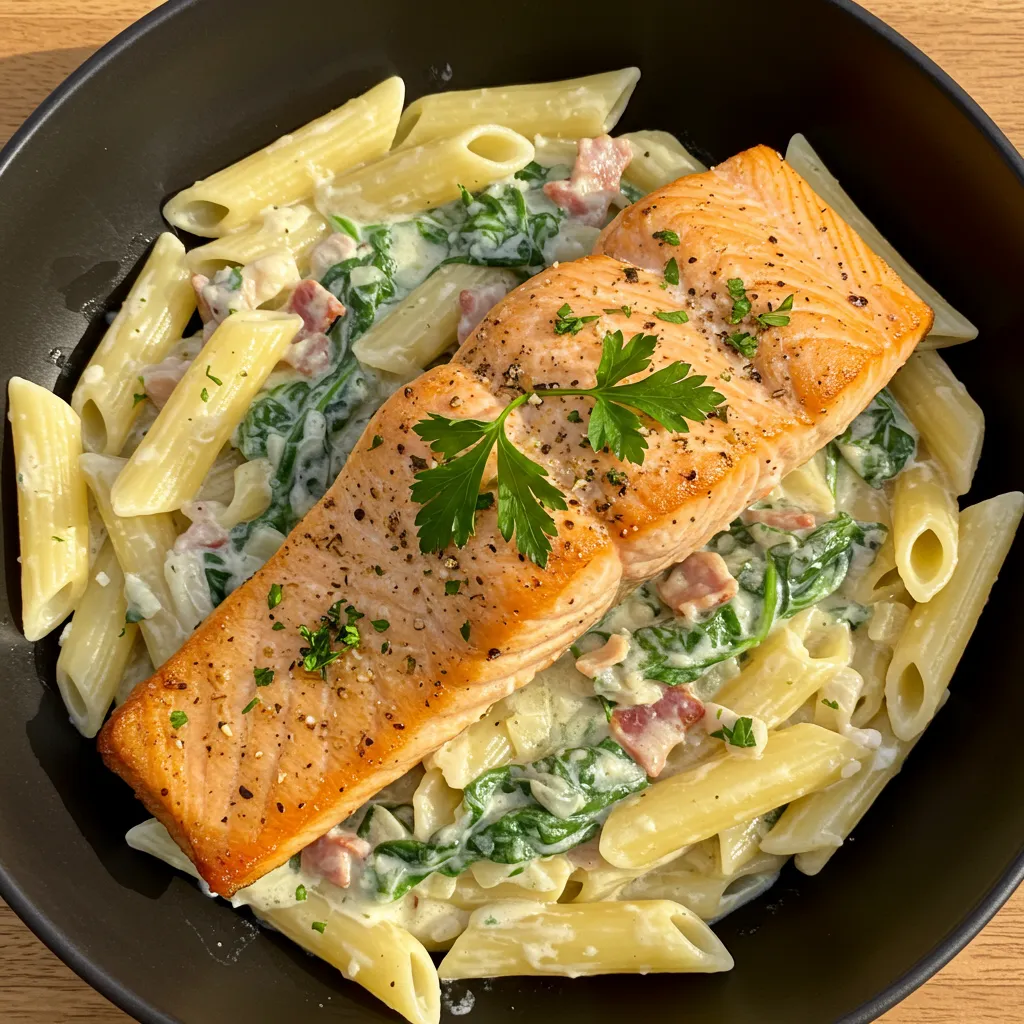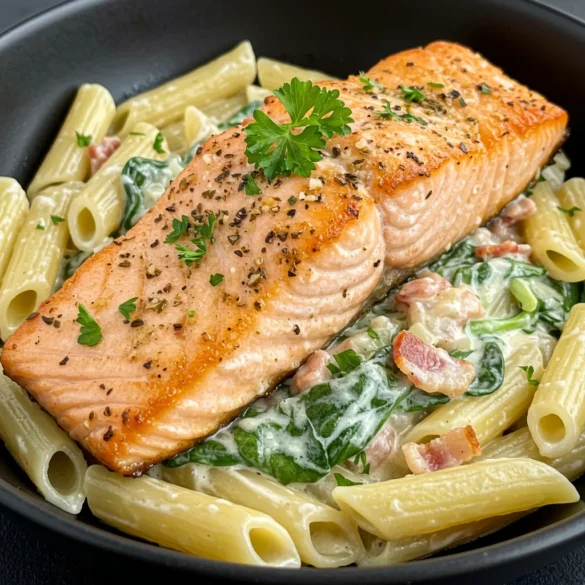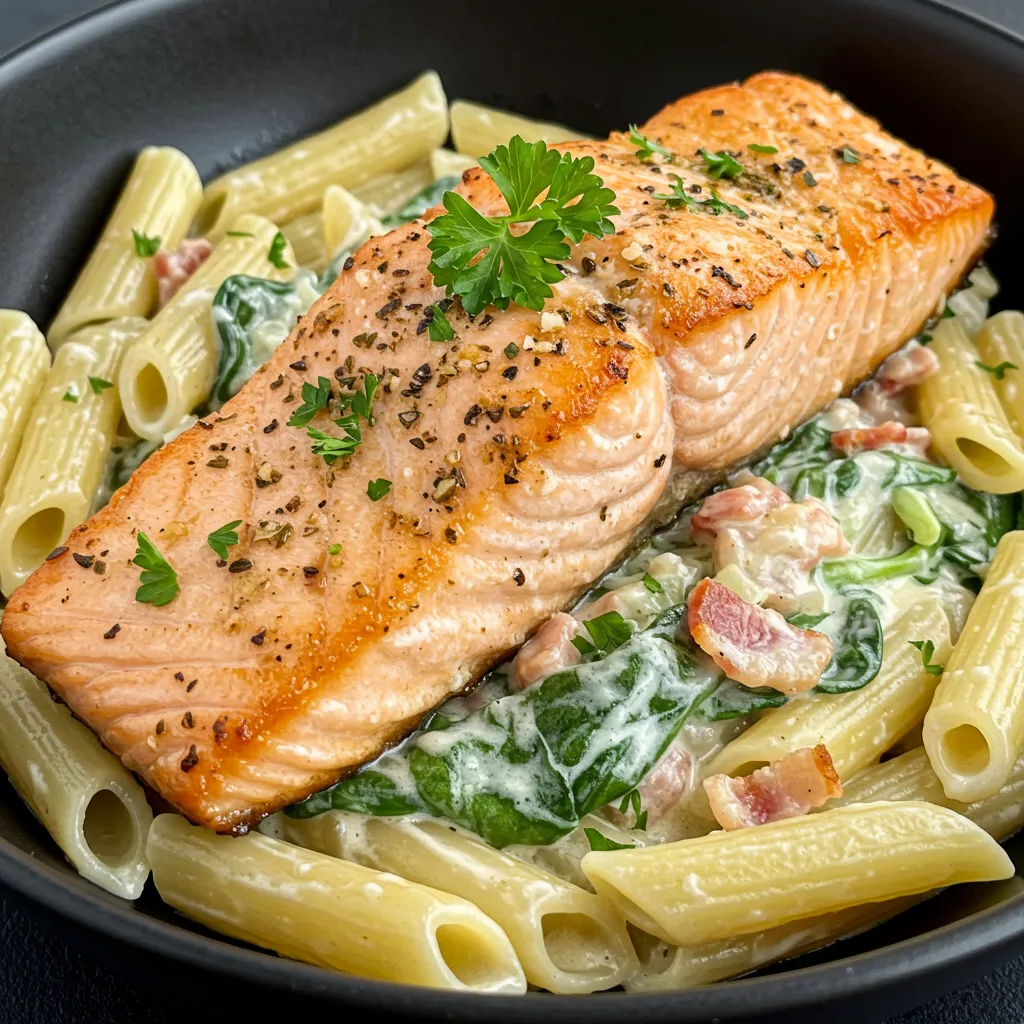This elegant Creamy Salmon Alfredo Pasta combines perfectly seared salmon with al dente rigatoni in a luxuriously rich, garlic-infused cream sauce. The salmon fillet, with its crispy, seasoned exterior and tender, flaky interior, sits majestically atop a bed of pasta that’s generously coated in a velvety sauce enhanced with Parmesan cheese, fresh herbs, and savory pancetta. Each bite delivers a harmonious blend of the pasta’s comforting texture, the salmon’s delicate flavor, and the sauce’s indulgent creaminess. Finished with a sprinkle of fresh parsley that adds a pop of color and herbaceous brightness, this dish strikes the perfect balance between sophisticated restaurant fare and achievable home cooking—ideal for special dinners, date nights, or whenever you crave a meal that feels both luxurious and comforting.
Why You’ll Love This Recipe
- Restaurant-quality at home: Creates an impressive dish that rivals fine dining experiences
- Perfect protein balance: Combines rich salmon with creamy pasta for a satisfying meal
- Versatile elegance: Suitable for both weeknight dinners and special occasions
- One-pan potential: Main components can be prepared in the same skillet for minimal cleanup
- Customizable heat level: Easily adjust the red pepper flakes to suit any preference
- Make-ahead components: Prepare elements separately and assemble just before serving
- Balanced flavors: Creamy sauce perfectly complements the salmon without overwhelming it
- Visually stunning: Creates a beautiful presentation with minimal effort
- Nutritionally complete: Provides protein, carbohydrates, and healthy fats in one dish
Ingredients
For the Salmon
- Salmon fillets – The star protein, providing rich flavor and heart-healthy omega-3 fatty acids
- Kosher salt – Enhances the salmon’s natural flavor and helps create a perfect crust
- Black pepper – Adds gentle heat and depth to the salmon’s exterior
- Paprika – Creates beautiful color and subtle smoky flavor on the fish
- Garlic powder – Infuses the salmon with aromatic flavor without burning like fresh garlic
- Olive oil – Facilitates perfect searing and adds fruity notes
- Unsalted butter – Creates a beautiful finish and rich flavor when basting the salmon
For the Pasta and Alfredo Sauce
- Rigatoni pasta – Large tubular shape captures the creamy sauce perfectly
- Unsalted butter – Forms the base of the Alfredo sauce
- Pancetta or bacon – Adds savory depth and subtle smokiness to the dish
- Shallots – Provide a milder, sweeter alternative to onions that won’t overpower the salmon
- Garlic – Creates an aromatic foundation for the sauce
- Heavy cream – Gives the sauce its luxurious, velvety texture
- Parmesan cheese – Adds nutty, salty flavor and helps thicken the sauce
- White wine – Deglazes the pan and adds acidity to balance the cream
- Lemon juice – Brightens the entire dish and complements the salmon perfectly
- Fresh parsley – Adds color and herbal freshness
- Baby spinach – Incorporates vegetables and vibrant color into the dish
- Red pepper flakes – Provide gentle heat that enhances all flavors
- Nutmeg – Adds subtle warmth and complexity to the cream sauce
For Garnish
- Additional grated Parmesan – Adds final flavor boost and appealing presentation
- Fresh parsley – Provides bright color contrast and fresh flavor
- Lemon zest – Brightens the finished dish with citrus aroma
- Cracked black pepper – Adds final seasoning and visual appeal
Step-by-Step Instructions
Preparing the Salmon
Begin by preparing the salmon fillets. Pat 4 salmon fillets (about 6 ounces each) completely dry with paper towels. This crucial step ensures you’ll achieve a beautiful golden sear rather than steaming the fish.
In a small bowl, combine 1 teaspoon kosher salt, 1/2 teaspoon freshly ground black pepper, 1/2 teaspoon paprika, and 1/2 teaspoon garlic powder. Mix thoroughly to create a seasoning blend that will form a flavorful crust on the salmon.
Season the salmon fillets generously on both sides with the spice mixture, pressing gently to adhere. Focus particularly on the flesh side, which will be presented facing up on the final dish.
Heat a large, heavy-bottomed skillet (preferably cast iron) over medium-high heat. Add 2 tablespoons olive oil and allow it to heat until shimmering but not smoking.
Carefully place the salmon fillets in the hot skillet, skin-side down if your fillets have skin. Avoid overcrowding by cooking in batches if necessary. The fish should sizzle immediately upon contact with the pan.
Cook undisturbed for 3-4 minutes until the skin is crispy or the bottom has developed a golden crust. This patience allows the protein to release naturally from the pan rather than sticking and tearing.
Add 2 tablespoons unsalted butter to the pan. As it melts, tilt the pan slightly and use a spoon to baste the salmon with the butter-oil mixture, which helps cook the top while adding richness.
Gently flip the salmon and cook for an additional 2-3 minutes for medium doneness. The center should be slightly translucent if you prefer medium-rare salmon, or cook 1-2 minutes longer for well-done, depending on the thickness of your fillets.
Transfer the salmon to a plate and tent loosely with foil to keep warm while preparing the pasta and sauce. The salmon will continue cooking slightly from residual heat.
Cooking the Pasta
Bring a large pot of water to a rolling boil. Add 1 tablespoon salt to the water—this seasons the pasta from within as it cooks.
Add 12 ounces of rigatoni pasta to the boiling water and cook according to package directions until al dente, typically 10-12 minutes. The pasta should retain a slight firmness when bitten.
Reserve 1 cup of the starchy pasta cooking water before draining. This water contains starches that will help thicken your sauce and help it cling to the pasta.
Drain the pasta but do not rinse it. The surface starch helps the sauce adhere better to each piece. Set aside while preparing the sauce.
Making the Creamy Alfredo Sauce
Using the same skillet in which you cooked the salmon (without cleaning it), reduce heat to medium and add 4 ounces diced pancetta or bacon. The rendered fat from the meat will incorporate the flavorful salmon bits left in the pan.
Cook the pancetta until crispy, about 3-4 minutes, stirring occasionally. The fat should render out and the meat should become golden and crisp.
Add 1 finely diced shallot to the pancetta and cook for 2 minutes until softened and translucent but not browned.
Add 4 minced garlic cloves and cook for just 30 seconds until fragrant. Be careful not to brown the garlic as it can become bitter.
Pour in 1/4 cup dry white wine (such as Pinot Grigio or Sauvignon Blanc) to deglaze the pan, using a wooden spoon to scrape up any browned bits from the bottom of the skillet. These contain concentrated flavor that will enhance your sauce.
Allow the wine to reduce by half, about 1-2 minutes, which concentrates the flavor while cooking off the alcohol.
Lower the heat to medium-low and add 2 tablespoons butter to the pan, allowing it to melt completely.
Slowly pour in 2 cups heavy cream while stirring constantly. The gradual addition prevents the cream from separating or curdling.
Bring the mixture to a gentle simmer (never a boil, which can cause the cream to separate) and cook for about 3-4 minutes until it begins to thicken slightly.
Gradually add 1 cup freshly grated Parmesan cheese, stirring continuously until completely melted and incorporated. The sauce should be smooth and coat the back of a spoon.
Add 1 tablespoon fresh lemon juice, 1/4 teaspoon freshly grated nutmeg, 1/4 teaspoon red pepper flakes (adjust to taste), 1/2 teaspoon salt, and 1/4 teaspoon black pepper. Stir to combine thoroughly.
Add 2 cups baby spinach to the sauce and stir until just wilted, about 1 minute. The heat from the sauce will perfectly wilt the spinach without making it mushy.
Assembling the Dish
Add the drained rigatoni directly to the skillet with the sauce, tossing gently to coat each piece thoroughly. If the sauce seems too thick, add the reserved pasta water a few tablespoons at a time until you reach your desired consistency.
Stir in 1/4 cup chopped fresh parsley, reserving some for garnish. The herbs should be added at the last minute to maintain their bright flavor and color.
Allow the pasta to simmer in the sauce for 1-2 minutes, which helps it absorb the flavors and thicken the sauce slightly.
Taste and adjust seasonings as needed, adding more salt, pepper, or red pepper flakes according to your preference.
Plating and Serving
For an impressive presentation, place a generous portion of the creamy pasta in the center of each warmed plate or shallow bowl, creating a slight well in the center.
Carefully place a salmon fillet on top of each pasta portion, positioning it slightly off-center to showcase both components.
Sprinkle each dish with additional grated Parmesan cheese, the reserved chopped parsley, a light dusting of lemon zest, and a final crack of black pepper.
For an extra touch of elegance, drizzle a small amount of high-quality olive oil around the edge of each plate.
Serve immediately while hot, accompanied by a crisp green salad and, if desired, a glass of the same white wine used in the sauce.

Pro Tips
- Allow salmon to come to room temperature for 15-20 minutes before cooking for more even doneness
- Cook pasta 1 minute less than package directions for perfect texture when finished in the sauce
- Grate Parmesan cheese fresh rather than using pre-grated for superior melting and flavor
- Add pasta water gradually to the sauce—you can always add more, but can’t take it away
- Use the side of your chef’s knife to crush whole garlic cloves before mincing for enhanced flavor
- Baste salmon continuously during cooking for even doneness and extra flavor
- For thicker sauce, mix 1 teaspoon cornstarch with 1 tablespoon cold water and stir into simmering sauce
- Add a splash of fish stock to the sauce for an intensified seafood flavor that complements the salmon
- Finish the dish with a small pat of butter swirled in for glossy presentation and enhanced mouthfeel
- For easier serving, remove salmon skin before cooking if you don’t plan to eat it
- Slightly undercook spinach as it will continue to wilt from residual heat
- Use a microplane for both Parmesan and nutmeg to ensure they incorporate smoothly
- Reserve some pasta cooking water even if you don’t think you’ll need it—it’s useful if sauce thickens too much upon standing
- Choose center-cut salmon fillets of equal thickness for the most consistent cooking results
- Pat pasta dry after draining if you want a thicker, less watery sauce
Variations and Creative Ideas
Flavor Variations
Tuscan Inspired: Add 1/2 cup sun-dried tomatoes and 1/2 cup artichoke hearts to the sauce. Enhance with 1 teaspoon Italian seasoning and finish with fresh basil instead of parsley.
Dill and Caper: Replace parsley with 3 tablespoons fresh dill and add 2 tablespoons capers to the sauce for a Scandinavian-inspired variation that complements salmon beautifully.
Smoked Salmon Version: Instead of seared salmon, fold 8 ounces of chopped smoked salmon into the pasta just before serving. The residual heat will warm it without cooking it further.
Lemon Pepper: Double the lemon juice and zest, and add 2 teaspoons coarsely ground black pepper to create a bright, zesty variation perfect for summer.
Pasta Alternatives
Fettuccine Classic: Use traditional fettuccine instead of rigatoni for a more classic Alfredo presentation that pays homage to the dish’s Italian roots.
Whole Wheat Option: Substitute whole wheat pasta for added fiber and nutty flavor that stands up well to the rich sauce and salmon.
Vegetable Noodles: Replace half or all of the pasta with zucchini noodles or spaghetti squash for a lower-carb alternative with added vegetables.
Gluten-Free Adaptation: Use high-quality gluten-free pasta made from corn and rice flours, which maintain their texture better than some alternatives.
Sauce Variations
Lighter Version: Replace half the heavy cream with unsalted chicken broth and use light cream cheese to maintain creaminess with fewer calories.
Vodka Sauce Twist: Add 2 tablespoons vodka instead of white wine and 1/4 cup tomato paste for a salmon vodka sauce variation.
Herb-Infused Cream: Steep the cream with sprigs of fresh herbs (thyme, rosemary) for 10 minutes before straining and using in the sauce.
Blue Cheese Addition: Replace 1/4 cup of the Parmesan with crumbled blue cheese for a more pungent, complex sauce that pairs surprisingly well with salmon.
Protein Substitutions
Mixed Seafood Delight: Replace the salmon with a combination of shrimp, scallops, and chunks of firm white fish for a seafood medley version.
Chicken Alternative: Substitute seared chicken breasts for salmon if serving guests with seafood allergies or preferences.
Vegetarian Option: Omit the salmon and pancetta, double the spinach, and add sautéed mushrooms and roasted cherry tomatoes for a vegetable-forward version.
Grilled Approach: Grill the salmon instead of pan-searing for a smoky flavor that contrasts beautifully with the creamy sauce.
Storage and Make-Ahead Advice
Salmon Storage:
- Cooked salmon can be refrigerated separately from the pasta for up to 2 days in an airtight container.
- For best results, reheat salmon gently in a 275°F oven for about 10 minutes until just warmed through.
- Avoid microwaving salmon as it can become dry and develop a strong fishy aroma.
Pasta and Sauce Storage:
- The pasta in Alfredo sauce can be refrigerated in an airtight container for up to 3 days.
- When reheating, add a splash of milk or cream to restore the sauce’s creamy consistency.
- Reheat pasta slowly over low heat on the stovetop, stirring frequently to prevent scorching.
- The sauce may separate slightly when stored; whisk vigorously while reheating to recombine.
Make-Ahead Strategy:
- Cook pasta ahead of time, toss with a small amount of olive oil, and refrigerate up to 1 day.
- Prepare the Alfredo sauce without adding the spinach and store separately for up to 2 days.
- Season the salmon and store uncovered in the refrigerator for up to 12 hours to develop flavor and dry the surface for better searing.
- When ready to serve, reheat sauce, add spinach, combine with pasta, and cook fresh salmon.
- For entertaining, prepare everything except the salmon up to 2 hours ahead, then cook salmon just before serving.
Freezing Guidelines:
- Alfredo sauce alone (without pasta) can be frozen for up to 1 month, though it may separate slightly when thawed.
- To restore frozen sauce, thaw overnight in the refrigerator, then heat slowly while whisking continuously.
- Cooked pasta with sauce does not freeze well as the pasta continues to absorb liquid and becomes mushy.
- Cooked salmon is not ideal for freezing as it tends to become dry and change texture when thawed.
Reheating Tips:
- Always reheat cream-based pasta dishes on low heat to prevent separation.
- Add liquid (cream, milk, or pasta water) a tablespoon at a time when reheating to maintain creamy consistency.
- For best results with leftovers, plate pasta and sauce first, heat gently, then add warmed salmon on top at the last minute.
- Consider consuming leftovers at room temperature or slightly chilled as a pasta salad alternative if concerned about overcooking the salmon.
Kid-Friendly Involvement
This sophisticated dish offers several opportunities for children to participate in the kitchen:
Measuring Ingredients: Kids can help measure pasta, spices, and liquids, practicing math skills while contributing to the meal.
Seasoning the Salmon: Children can mix the dry seasonings and (with supervision) help apply the seasoning to the salmon fillets.
Tearing Spinach: Younger children can tear spinach leaves into smaller pieces, a safe task that helps them feel involved.
Stirring the Sauce: With supervision, older children can help stir the Alfredo sauce as it thickens, learning about how heat transforms ingredients.
Grating Cheese: Kids can help grate Parmesan cheese using a box grater or rotary cheese grater (with appropriate supervision).
Garnishing: Children of all ages can sprinkle the finished dishes with parsley, cheese, and other garnishes, developing pride in the final presentation.
Learning Opportunity: Use this recipe to teach about balanced meals containing protein (salmon), vegetables (spinach), and carbohydrates (pasta), as well as the importance of healthy fats from fish.
Frequently Asked Questions
How can I tell when my salmon is perfectly cooked? Perfectly cooked salmon should flake easily with a fork but still maintain some translucence in the very center. The internal temperature should reach approximately 125°F for medium-rare or 130°F for medium. The salmon will continue cooking slightly after being removed from heat. For visual cues, look for the flesh to change from translucent to opaque pink from the outside in, with just the center maintaining a slightly deeper color.
What can I substitute for heavy cream to make this lighter? For a lighter version, you can substitute half-and-half for the heavy cream, though the sauce won’t be quite as rich. Another option is to use 1 cup whole milk combined with 1 cup heavy cream. For even lighter versions, evaporated milk (not sweetened condensed) can work in a pinch, though the texture won’t be identical. In all cases, be extra careful with the heat to prevent curdling when using lower-fat dairy.
My sauce is too thin. How can I thicken it? If your sauce isn’t thickening properly, first try simmering it gently for a few more minutes. If that doesn’t work, make a slurry by mixing 1 teaspoon cornstarch with 1 tablespoon cold water until smooth, then whisk this into the simmering sauce. Another option is to add 2-3 additional tablespoons of freshly grated Parmesan, which adds both flavor and thickness. Remember that the sauce will also thicken slightly as it cools.
Can I make this dairy-free? Yes, though it will yield a different flavor profile. Replace butter with olive oil or dairy-free butter, and substitute the heavy cream with full-fat coconut milk or cashew cream. For the Parmesan cheese, nutritional yeast provides a somewhat similar flavor, though you may need to adjust quantities and add a bit more salt to compensate. Bear in mind that the final dish will have coconut undertones if using coconut milk.
What wine pairs best with this dish? This rich salmon pasta pairs beautifully with medium-bodied white wines with good acidity. Excellent choices include unoaked or lightly oaked Chardonnay, Pinot Grigio, Sauvignon Blanc, or a dry Riesling. The acidity helps cut through the richness of the cream sauce, while complementing the salmon’s flavor. For red wine lovers, a light Pinot Noir can work surprisingly well with salmon dishes.

Ingredients
For the Salmon:
4 salmon fillets (about 6 oz each)
1 teaspoon kosher salt
1/2 teaspoon freshly ground black pepper
1/2 teaspoon paprika
1/2 teaspoon garlic powder
2 tablespoons olive oil
2 tablespoons unsalted butter
For the Pasta and Alfredo Sauce:
12 oz rigatoni pasta
4 oz pancetta or bacon, diced
1 shallot, finely diced
4 garlic cloves, minced
1/4 cup dry white wine
2 tablespoons unsalted butter
2 cups heavy cream
1 cup freshly grated Parmesan cheese
1 tablespoon fresh lemon juice
1/4 teaspoon freshly grated nutmeg
1/4 teaspoon red pepper flakes (adjust to taste)
1/2 teaspoon salt
1/4 teaspoon black pepper
2 cups baby spinach
1/4 cup fresh parsley, chopped, plus more for garnish
For Garnish:
Additional grated Parmesan cheese
Fresh parsley, chopped
Lemon zest
Freshly cracked black pepper
Instructions
Pat salmon dry and season with salt, pepper, paprika, and garlic powder.
Sear salmon in olive oil for 3-4 minutes per side until golden and cooked to desired doneness; set aside.
Cook rigatoni in salted water until al dente; reserve 1 cup pasta water before draining.
In the same skillet used for salmon, cook diced pancetta until crispy.
Add shallot and garlic to pancetta; cook until fragrant.
Deglaze pan with white wine; reduce by half.
Add butter and heavy cream; simmer until slightly thickened.
Stir in Parmesan cheese until melted, then add lemon juice, nutmeg, red pepper flakes, salt, and pepper.
Add spinach and stir until wilted.
Combine pasta with sauce, adding reserved pasta water if needed for consistency.
Stir in fresh parsley and adjust seasonings.
Serve pasta topped with salmon and garnished with additional cheese, parsley, lemon zest, and black pepper.
Notes
Score the salmon skin with a sharp knife before cooking to prevent curling
Keep pasta slightly undercooked as it will continue to cook when added to the hot sauce
Warm your serving plates in a low oven for restaurant-style presentation
Shred cheese at the last minute for maximum freshness and better melting
Save time by asking your fishmonger to remove salmon skin if you prefer skinless fillets
If sauce becomes too thick, thin with pasta water; if too thin, add more cheese
For extra flavor, infuse the olive oil with a sprig of rosemary before cooking the salmon
Prepare all ingredients before starting to cook as this dish comes together quickly
Use freshly ground black pepper for noticeably better flavor than pre-ground
Cook pasta in well-salted water that "tastes like the sea" for proper seasoning
Allow cream to come to room temperature before adding to reduce risk of curdling
For presentation, wipe the rims of plates clean before serving
Choose heavy cream with higher fat content (at least 36%) for the most stable sauce
If possible, use European-style butter for richer flavor in both the salmon and sauce
Test salmon doneness by inserting a metal skewer into the thickest part and holding it against your wrist—it should feel warm, not hot
For easier serving and eating, remove pin bones from salmon before cooking
Use the back of a wooden spoon to press against the pan when deglazing to release all flavor compounds
When reheating leftover sauce, do so over very low heat to prevent separation
For deeper flavor in the sauce, add the rind of Parmesan cheese while simmering (remove before serving)
Choose wild-caught salmon when available for better flavor and sustainability

